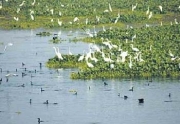 The Wetlands (Conservation and Management) Rules was notified in December 2010 by the Ministry of Environment and Forests to ensure better conservation and management and to prevent degradation of existing wetlands in India. Wetlands are critical for human development and wellbeing, especially in India where a large number of people are dependent on them for drinking water, food and livelihood. Despite their immense importance, wetlands are one of the most degraded ecosystems globally.
The Wetlands (Conservation and Management) Rules was notified in December 2010 by the Ministry of Environment and Forests to ensure better conservation and management and to prevent degradation of existing wetlands in India. Wetlands are critical for human development and wellbeing, especially in India where a large number of people are dependent on them for drinking water, food and livelihood. Despite their immense importance, wetlands are one of the most degraded ecosystems globally.
Wetland conservation has been accorded a high priority in India. Since 1987, the National Wetlands Conservation Programme of India has been financially supporting wetland conservation activities all over India. Under the Programme 115 wetlands have been identified for conservation and management till date. India is also a party to the Ramsar Convention under which 25 wetlands from India are included in the list of wetlands of international importance.
The Ministry of Environment and Forests, recognising the importance of having a legal framework for the preservation and management of wetlands in India, drew up a draft Regulatory Framework drawing upon the recommendation of a wide spectrum of experts and stakeholders. The draft was also made available for public comment on the Ministry’s website and all comments and suggestions received from the general public with regard to the draft framework were considered, and where possible, included in the Wetland Rules.
Under the Rules, wetlands have been classified for better management and easier identification. Central Wetland Regulatory Authority has been set up to ensure proper implementation of the Rules and perform all functions for management of wetlands in India. Apart from necessary government representatives, the Authority shall have a number of expert members to ensure that wetland conservation is carried out in the best possible manner.
In order to ensure there is no further degradation of wetlands, the Rules specify activities which are harmful to wetlands such as industrialisation, construction, dumping of untreated waste, reclamation etc. and prohibit these activities in the wetlands. Other activities such as harvesting, dredging etc may be carried out in the wetlands but only with prior permission from the concerned authorities.